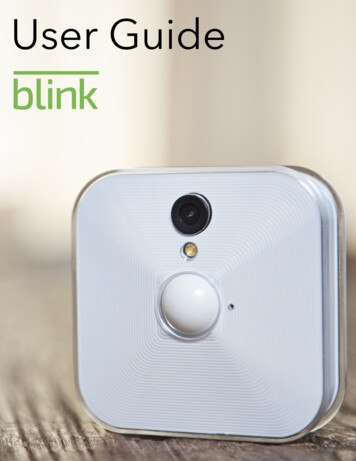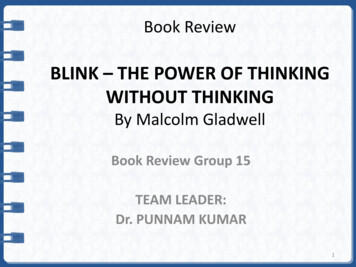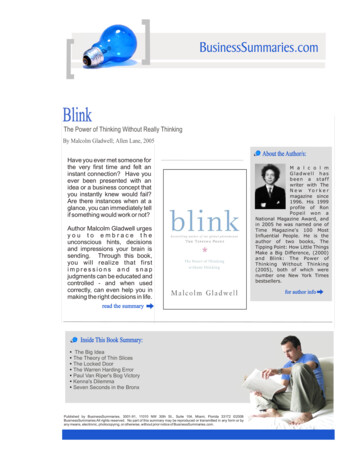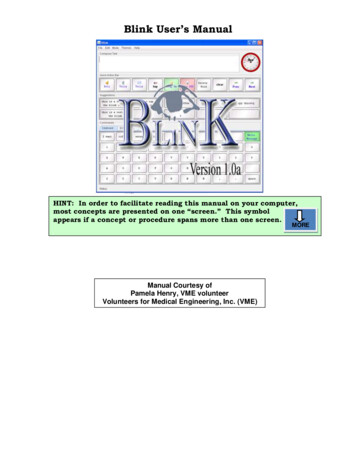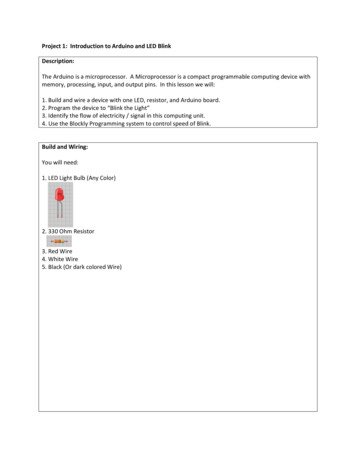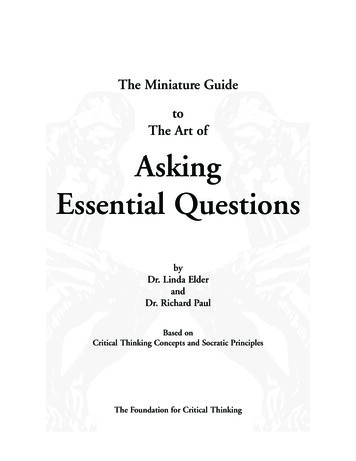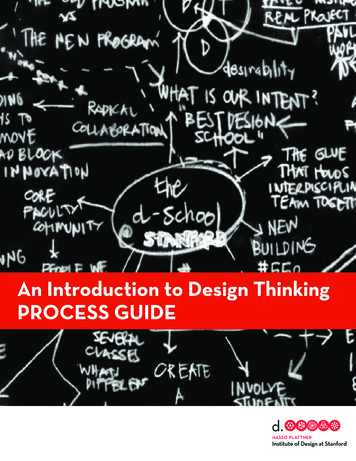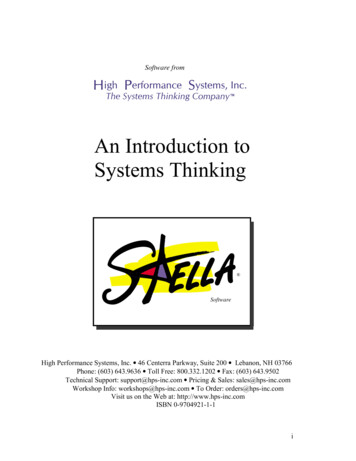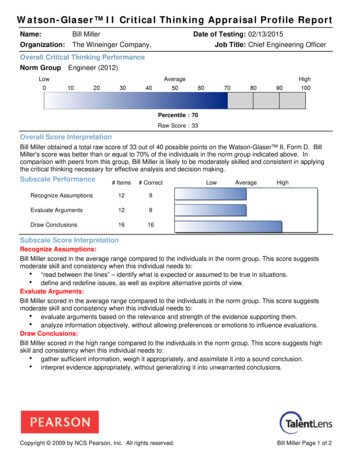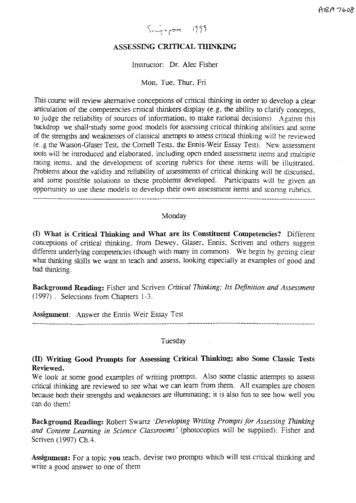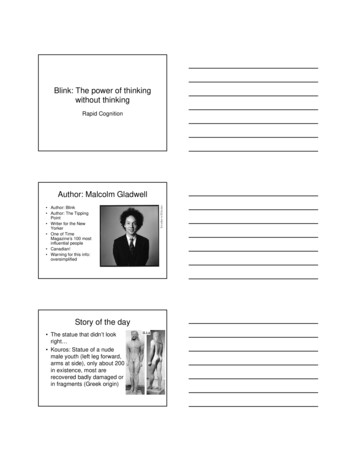
Transcription
Blink: The power of thinkingwithout thinkingRapid CognitionAuthor: Malcolm Gladwell Author: Blink Author: The TippingPoint Writer for the NewYorker One of TimeMagazine’s 100 mostinfluential people Canadian! Warning for this info:oversimplifiedStory of the day The statue that didn’t lookright Kouros: Statue of a nudemale youth (left leg forward,arms at side), only about 200in existence, most arerecovered badly damaged orin fragments (Greek origin)
Kouros In 1983, an art dealer claimed he had aperfectly preserved Kouros which he triedto sell to the J. Paul Getty museum for 10million dollars The museum proceeds slowly, runningmultiple tests on the kourosKouros Statue was made of dolomite marble andwas covered by a layer ofcalcite important because dolomite turnsinto calcite over the course of hundreds orthousands of years didn’t appear to be acontemporary fake The kouros was purchased by themuseum after a 14 month investigationProblem: The statue didn’t look right One art historian first noted this while staring at thefingernails of the statue but couldn’t articulate theproblem An expert on Greek sculpture also felt it was fake themoment she saw it but wasn’t sure why A former museum director noted that his first thoughtupon seeing the statue was “fresh”, not the expectedreaction to a 2000 year old statue No one could articulate the problem, every one of theseexperts, however, had an instinctive sense that thestatue was a fake
The statue was sent to Athens to beinvestigated by the foremost sculptureexperts Every expert thought something waswrong on first glance but couldn’t articulatewhy One expert noted that on first glance, hefelt “intuitive repulsion” Still, all scientific tests on the authenticityof the statue checked out Soon, however, the case falls apart theauthenticity of documents called intoquestion (postal code), incredibly carefulexamination showed that the design of thekouros mimicked several different stylesand time periods Later analyses showed that you could agethe surface of dolomite marble using apotato mold Statue turned out to be a modern forgery None of this would have been discoveredin the absence of “intuitive repulsion” thatoccurred in many the first moment theyglanced at the statueMother always told us Haste makes wasteLook before you leapStop and thinkDon’t judge a book by it’s cover We’re taught that we’re better off gathering asmuch information as possible and spending asmuch time deliberating as possible but is it thecase that doing so is actually a bad idea?
An example Picture a gambling game in which you arefaced with 4 decks two red and two blue Each card in each deck either wins youmoney or costs you money, your task is tomaximize winnings and minimize losingsAn example What you’re not told: the red decks are aminefield high rewards but when youlose you lose big The only way to win is by taking cardsfrom the blue decks, steady payouts, lowpenalties How long will it take you to figure that out? Most people figure out how to play afterturning over 50 cards but can’t articulatethe rules After 80 cards, you’ve figured out thegame and can explain why to avoid certaindecks This makes sense, it’s learning we haveexperiences, think them through, and drawconclusions What if we measure knowledge in adifferent way though (similar to implicitlearning)
Participants are hooked up to a machinethat measures activity of the sweat gland,below the skins in the palm of their hands(skin conductance responds to stress aswell as temperature) Stress responses are generated to the reddecks after only 10 cards are turned over,40 cards before conscious knowledgekicks in After 10 cards people draw from the bluedeck moreso People have actually figured the game outwell before they know they have In a high stakes situation where a lot ofinformation is being taken in in a short period oftime, our brain uses two very different strategiesto make sense of the world 1) Conscious strategy – we think about whatwe’ve learned and reach a logical and definitiveconclusion, but it takes us awhile to get to thispoint (slow moving) 2) Unconscious strategy – operates far morequickly, very smart, identifies patternsimmediately, the only downside is we’re notaware of it It’s the second strategy that influenced theexperts examining the kourosThe Adaptive Unconscious The part of our brain that leaps towardsconclusions (not to be confused withFreud’s notion of unconscious) Essentially a giant computer that quicklyand quietly processes a lot of informationto allow us to function normally Quick decision making process What do you do when a truck is bearingdown on you or someone throws a punchat you?
The Adaptive Unconscious The mind operates efficiently by leaving alot of high-level sophisticated thinking tothe unconscious much like pilots planescan fly on autopilot Adaptive unconscious sizes up world,warns of us dangers, sets goals andinitiates actions We tend to switch back and forth betweenconscious and unconscious modes ofthinkingHow quickly can you determine aprofessor’s teaching effectiveness? Ambady & Rosenthal (1993) Students shown a 10 second, 5 second, or2 second clip of a professor with the soundturned off and are asked to rate teachingeffectiveness Ratings compared with ratings at the endof the semester No difference in ratingsRapid cognition We tend to be suspicious of rapid processingdue to how we’re taught to think (more research,more tests, etc.) Present purpose– 1) To convince you that the decisions we makerapidly are often as good as those we make after agood deal of time and thought– 2) To determine the situations in which ourunconscious fails us (why did that museum purchasethe kouros?)– 3) Snap judgments can be controlled and we canteach ourselves to make better snap judgments
How rapid cognition applies Decision makingAttentionAutomaticityExpertiseKeep in mind our unconscious is powerful, but fallible,it can be thrown off, our instinctivereactions can go awry Normally when this happens though,there’s a reasonThin slicing: a little knowledge goesa long way John Gottman,Washington University Marital stability andrelationship analysis Claims to be able toassess the likelihood ofdivorce just bywatching briefinteractions
Couples seated on chairs facing eachother with electrodes and sensors clippedto their fingers and ears (measures heartrate, skin temperature, sweat) Chairs are motion sensitive to determinehow much people move around Videotape interactions in which couple isasked to talk about a contentious issuefrom their marriageWhat can be learned in 15minutes? Can you tell if someone’s marriage ishealthy/unhealthy when viewing themhaving a discussion about a single topic? To really know a couple, wouldn’t youneed to see them interact over time indifferent situations? Gottman says no, 15 minutes is all it takesto predict future relationship successSPAFF Gottman analyzes all interactions withSPAFF (specific affect), a coding systemwith 20 categories corresponding to anyemotion that may be expressed during theconversation (e.g. contempt is 2, anger is7, defensiveness is 10) Students code every second of everyinteraction The coded information is then added to anequation that also factors in the data fromthe electrodes and sensors
How much can you tell from thedata? If you look at one hour of interaction,ability to predict whether the couple willstill be together in 15 years is 95% If you look at 15 minutes, can still predictwith up to 90% accuracy Even after viewing only 3 minutes, yourability to predict marriage stability is quitehigh How can one be so accurate with littleinformation?Thin-slicing A critical aspect of rapid cognition Thin-slicing is the ability of ourunconscious to find patterns in situationsand behaviors based on narrow slices ofexperience When our unconscious thin-slices, it isdoing an automated, accelerated,unconscious version of what Gottmandoes with his videotapes and calculationsThin slicing comes about due to expertise What Gottman is able to do comes about due tohis years of experience coding tapes Claims he can now here couples discuss thingsover dinner and know whether or not they’llmake it Our unconscious is able to thin slice for thesame reason, lots of experience with thingsmakes them automatic (like driving a car)
Expertise As people become experienced at codingSPAFF, patterns of behavior jump out thatwouldn’t be perceived otherwise (e.g., eyerolling, word choices, yes-but, tone) What is actually being measured ispositive and negative emotionindependent of what is said interactionsthat appear positive can actually be verynegativeExpertise As people become experienced at codingSPAFF, patterns of behavior jump out thatwouldn’t be perceived otherwise (e.g., eyerolling, word choices, yes-but, tone) What is actually being measured ispositive and negative emotionindependent of what is said interactionsthat appear positive can actually be verynegativeWhat exactly is our unconsciousbasing it’s decision on? Fists – distinctive patterns A fist is a term used in Morse code, eventhough dots and dashes are standard,everyone has their own specific fist – dotsand dashes are formed with variousspacing and rhythm for each individual
What exactly is our unconsciousbasing it’s decision on? In WW2, the British were able to learn about theGermans by analyzing fists rather than particularmessage content (certain operators were withcertain units and by determining their fist theycould pick up on where each unit was at a giventime) Critically: fists emerge naturally, your personalitytends to express itself automatically andunconsciously Relationships also have fists which areexpressed during interactions, one needs toknow how to pick up on them Turns out that there are shortcuts to this as well Selectivity is key (picking up on the mostimportant determinants) For relationships, there are 4 critical negativepredictors: defensiveness, stonewalling,criticism, and contempt Contempt is by and large the most importantdeterminant of marital stability (contempt isessentially any statement of superiority, madefrom a higher level)Contempt Contempt also correlates with the number ofcolds a husband/wife gets in a year being inthe presence of contempt is so stressful it candamage your immune system This seems to be how our unconscious works:when we leap to a decision our unconscious isthrowing out irrelevant info and zeroing in on theimportant stuff As a result thin-slicing is sometimes better thandeliberative/exhaustive thinking
Another example If you’re going to hire someone for a job,what’s the more effective approach?– A) Meet with the prospective hire twice aweek for a year– B) Go to his/her house and spend a half hourlooking around We’re generally taught that option a) iscorrectSamuel Gosling Uses the Big 5inventory to studypersonality– Extraversion– Agreeableness– Conscientiousness– Emotion Stability– Openness to newexperiencesGosling et al., 2002 80 subjects all of whom fill out a questionnairetapping into the Big Five The subjects then select their closest friends tofill out the same questionnaire describing them Then the experimenter took strangers who hadnever met the students, gave them the samequestionnaire (is this person talkative, original,reserved, etc.), and asked them to fill it out afterspending 15 minutes looking through thesubjects dorm room (no interaction withindividual)
How does everyone do Friends describe us accurately How about strangers:– Not good at determining extraversion (really need tointeract with someone to determine this)– Slightly less better than friends at determiningagreeableness (also probably need to interact withsomeone)– For the other three scales though (conscientiousness,emotional stability, openness to experience),strangers are actually more accurate than friends– Overall, strangers rate us better than our friends do– This is another example of thin-slicingWhat can a bedroom tell you? Three kinds of clues about personality– Deliberate expressions of how we’d like to beviewed by the world (e.g., framed degree)– Behavioural residue: inadvertent clues suchas dirty laundry or alphabetized CD collection– Thought and feeling regulators: scentedcandles, decorative pillowsMore importantly, what informationdo you not get from a bedroom? When you meet someone face to face anumber of confusing, complicated, andirrelevant pieces of information can beobtained which mess up your judgment(e.g., if you met a football player who wasa philosopher, could you get by the dumbjock bias what if you just saw hisbookcase?)
People aren’t very good at being objectiveabout their own personality, they may lie,so we ask questions to get around thisrather than straightforward questions (e.g.what is your marriage like) Strangers can cut through this by simplyobserving your room, Gottman cutsthrough this by examiningpositive/negative nature of interactionsindependent of content of interactionsYet another example Imagine you work for an insurancecompany that sells medical malpracticeprotection it is your job to determinewhich physicians are most likely to besued .do you– A) examine each physicians’ training andcredentials, analyze past performance forerrors– B) Listen in on brief snippets between eachdoctor and his/her patientWhy people sue Often times shoddy medical care goesunpunished, people sue because ofshoddy medical care plus something else Physician demeanor: physicians who takemore time answering questions in afriendly/gentle tone are rarely sued, thosewho are rushed, blunt, or unclear, areoften sued
Levinson et al., 1997 What differentiates surgeons who have neverbeen sued relative to those who have been suedtwice or more? Surgeons who have never been sued – Spend about 3 minutes more with each patient– More likely to make
Blink: The power of thinking without thinking Rapid Cognition Author: Malcolm Gladwell Author: Blink Author: The Tipping Point Writer for the New Yorker One of Time Magazine’s 100 most influential people Canadian! Warning for this info: oversimplified Story of the day The statue that didn’t look right Kouros: Statue of a nude male youth (left leg forward .File Size: 733KBPage Count: 59
